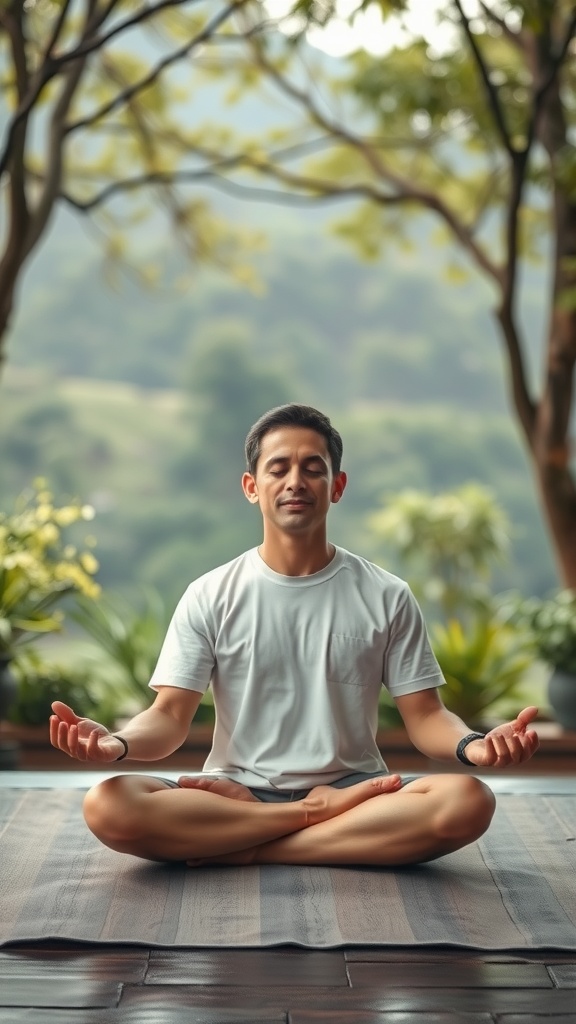When it comes to meditation, two popular styles often come up: mindfulness meditation and spiritual meditation. While both practices aim to enhance self-awareness and promote inner peace, they differ in their focuses and techniques. Mindfulness meditation is all about being present in the moment and observing thoughts without judgment, while spiritual meditation tends to incorporate a deeper exploration of beliefs and a connection to something greater than oneself. Let’s dive into the nuances of each to see how they compare.
Benefits of Spiritual Meditation

Spiritual meditation often combines mindfulness with a deeper connection to something greater. This method helps individuals tap into their inner selves, fostering a sense of peace and contentment.
In the image, we see a person meditating peacefully in a natural setting. The soft glow radiating from their heart area symbolizes the energy and warmth that spiritual meditation can evoke. This visual reflects the calmness that many experience during their practice.
One of the key benefits of spiritual meditation is improved emotional stability. As we engage in this practice, we learn to observe our thoughts and feelings without judgment, allowing us to respond to emotions more thoughtfully. This can lead to healthier relationships and less stress.
Additionally, spiritual meditation can enhance our sense of purpose. By connecting with our inner selves, we often gain insights into our values and beliefs. This clarity can guide our decisions and help us live more authentically.
Another advantage is the cultivation of compassion. Many spiritual practices encourage us to extend loving-kindness to ourselves and others. This shift in perspective can lead to more fulfilling interactions and a greater sense of community.
Key Differences Between Mindfulness and Spiritual Meditation

The image highlights the contrast between mindfulness meditation and spiritual meditation. The soothing design and calming colors reflect the essence of mindfulness, which is all about being present in the moment. Mindfulness meditation encourages people to focus on their breath and surroundings, promoting awareness and acceptance.
On the other hand, spiritual meditation often dives deeper into personal beliefs and connection to a higher power or purpose. It may involve visualizations, mantras, or prayers. While mindfulness cultivates a sense of peace in the here and now, spiritual meditation can take you on a journey of self-discovery and connection.
In short, mindfulness is about observing thoughts and feelings without judgment, while spiritual meditation often seeks a deeper understanding of existence. Both practices offer unique benefits, but they cater to different needs and experiences.
Benefits of Mindfulness Meditation

Mindfulness meditation is all about being present in the moment. In the image, we see a person meditating in a peaceful setting, surrounded by nature. This calm atmosphere reflects the essence of mindfulness—finding tranquility within ourselves.
One major benefit of mindfulness meditation is stress reduction. As you focus on your breath and observe your thoughts, you can let go of anxiety. Just like the individual in the photo, who appears relaxed and centered, practicing mindfulness can help you feel grounded and at ease.
Another advantage is improved concentration. Regular mindfulness practice helps sharpen your focus, making it easier to tackle daily tasks. The serene environment in the image symbolizes the clarity that comes with a mindful mindset.
Mindfulness meditation also promotes emotional health. It encourages self-awareness, helping you understand your feelings better. This can lead to a more positive outlook on life. The peaceful expression on the person’s face in the image hints at the joy that can come from such self-discovery.
Finally, mindfulness can enhance your overall well-being. By being present, you can appreciate small moments and cultivate gratitude. The natural setting in the image suggests a connection to the world around us, which is a key aspect of mindfulness.
Exploring Spiritual Meditation

Spiritual meditation is about connecting with a deeper sense of self and exploring the universe’s mysteries. In the image, we see a serene figure sitting in meditation, surrounded by glowing symbols and lights. This visual represents the energy and focus involved in spiritual practices.
Unlike mindfulness meditation, which emphasizes being present in the moment, spiritual meditation often incorporates elements of visualization and intention-setting. The figure holds a candle and lotus flowers, which symbolize purity, enlightenment, and the journey of self-discovery.
The ethereal background filled with symbols can represent various spiritual beliefs and philosophies. This highlights how spiritual meditation can draw from different traditions, inviting practitioners to explore their own beliefs while fostering a sense of community and connection.
Practicing spiritual meditation can be a gentle way to explore your inner self while also embracing the vastness of the universe. It encourages asking questions like, ‘What is my purpose?’ and ‘How do I connect with something greater than myself?’ By engaging with these ideas, individuals often find a more profound sense of peace and purpose.
Techniques Used in Spiritual Meditation

Spiritual meditation often draws on various techniques to deepen the practice. One common approach is visualization, where practitioners imagine symbols or images that resonate with their spiritual beliefs. This can create a sense of connection to something greater than themselves.
Another method involves mantra repetition. By silently repeating a specific phrase or sound, individuals can focus their minds and open themselves to spiritual insights. The rhythmic nature of this practice can enhance relaxation and elevate consciousness.
Breathwork is also a fundamental technique in spiritual meditation. Focusing on the breath helps calm the mind and body, facilitating a more profound spiritual experience. This can lead to moments of clarity or profound insight.
Additionally, some may incorporate nature into their practice. Meditating outdoors can foster a deeper connection with the universe, allowing for a more holistic experience. The serene environment can enhance the feeling of unity with nature and spirituality.
Techniques Used in Mindfulness Meditation

Mindfulness meditation focuses on being present in the moment. It’s about observing your thoughts and feelings without judgment. This practice helps cultivate a sense of awareness, allowing you to connect with your inner self.
A common technique is to focus on your breath. Sit comfortably and take deep breaths, feeling the air enter and leave your body. This simple act can ground you and bring your mind back from wandering thoughts.
Body scan meditation is another effective method. In this technique, you mentally scan your body from head to toe, noticing any sensations or tension. This helps build a connection between your mind and body.
Guided imagery is also popular. You can visualize a peaceful scene, like a beach or forest, to calm your mind. Imagining these serene places can transport you away from stress and into relaxation.
Lastly, mindful walking is a wonderful practice. As you walk, pay attention to each step. Feel the ground beneath your feet and notice the rhythm of your movement. This encourages you to stay anchored in the present.
Understanding Mindfulness Meditation

Mindfulness meditation is all about being present in the moment. In the image, we see a person sitting peacefully, absorbing the serene landscape around them. This setting is perfect for mindfulness practice, allowing one to focus on their breath and the sensations of their body.
The essence of mindfulness meditation lies in observing thoughts without judgment. Just like the individual in the image, you might find a quiet spot that helps you connect with nature and yourself. It’s about tuning into the here and now.
The calmness depicted encourages us to leave distractions behind and immerse ourselves in the present. This practice often leads to reduced stress and a greater sense of well-being. Whether you’re a beginner or seasoned meditator, creating a tranquil environment can enhance your experience.
The Role of Breath in Mindfulness Meditation

In mindfulness meditation, breath serves as an anchor. It helps bring your focus back when your mind starts to wander. The image of a person calmly sitting by a serene lake reflects this practice beautifully. You can almost feel the peace emanating from that scene.
When you pay attention to your breath, you invite a sense of calm into your day. The fresh air and natural surroundings depicted in the image remind us that connecting with nature can enhance this experience. Just like the person in the photo, finding a quiet spot can make it easier to focus on your breath.
Breathing slowly and deeply encourages relaxation. Each inhale fills your body with energy, while each exhale releases tension. This simple act can ground you, helping you stay present. The tranquility of the lake in the background symbolizes the stillness that your mind can achieve through this practice.
As you breathe, notice how your body feels. The gentle movement of your chest and abdomen reminds you to stay in the moment. Just like the lush greenery surrounding the figure in the image, your breath nourishes your mind and spirit. Embracing this connection is key to deepening your mindfulness meditation practice.
Choosing the Right Meditation Practice for You

In the image, we see an individual sitting peacefully in nature. Their relaxed posture suggests a moment of deep concentration or reflection. The autumn leaves scattered around them create a serene atmosphere, perfect for meditation. The bare branches of the tree in the background symbolize a sense of stillness and introspection.
This scene sets a lovely backdrop for discussing mindfulness meditation versus spiritual meditation. Each style has its unique benefits and might resonate differently with people. Mindfulness meditation focuses on being present in the moment, helping you observe your thoughts without judgment. On the other hand, spiritual meditation often involves a connection to something greater, like the universe or a higher consciousness.
Choosing the right practice really depends on what you are seeking. If you’re looking for stress relief and a way to cultivate awareness, mindfulness might be your go-to. But if you’re interested in exploring your spiritual side or seeking personal growth, spiritual meditation could be the way to go. It’s all about finding what feels right for you!
The Role of Intention in Spiritual Meditation

In spiritual meditation, intention is key. The image shows a person sitting peacefully by the water, suggesting a deep connection with nature. This serene setting reflects the idea that our surroundings can enhance our meditation experience.
The choice of intention in spiritual meditation often guides the experience. When we set a clear purpose, whether it’s to cultivate love, seek guidance, or connect with the universe, we create a focused mindset. This is vital for deeper exploration.
In contrast to mindfulness meditation, which often emphasizes being present in the moment, spiritual meditation invites us to reach beyond ourselves. It encourages seeking something greater. The individual in the image, with their calm posture and focused gaze, embodies this journey of exploration.
Moreover, intention helps in navigating distractions. As we meditate, thoughts may drift away. Having a strong intention can bring us back to our center. It’s about creating a personal connection to what matters most.
In essence, intention shapes our spiritual meditation practice. It allows us to engage more deeply with our inner selves and the world around us. The tranquil scene in the image beautifully illustrates this harmony.